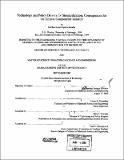Technology and policy drivers for standardization : consequences for the optical components industry
Author(s)
Speerschneider, Michael James, 1975-
DownloadFull printable version (9.773Mb)
Other Contributors
Massachusetts Institute of Technology. Technology and Policy Program.
Advisor
Lionel C. Kimerling.
Terms of use
Metadata
Show full item recordAbstract
Optical communications promise the delivery of high bandwidth service to all types of customers. The potential for optical communications is enormous and has generated excitement and anticipation over the last decade. However, the emergence of a growing market has not materialized and the 1990s communications "bubble" has burst. One result of the bubble burst is that manufacturers of optical components have seen demand for their products plummet and are now struggling to survive. The future of the communications industry depends on its ability to provide better services and higher reliability. At some point, the upward curve of communications demand will require a strong optical components industry to support the industry. If the current stagnation continues, and the manufacturers fail, the economic pillar that is communications will suffer. The MIT Microphotonics Center has initiated a Communications Technology Roadmap study to better understand the technical, economic, and political factors that are inhibiting growth in the optical communications industry. This thesis examines the current state of the optoelectronic manufacturing industry and the causes of the decline. The primary focus is the rampant proliferation of optical transceiver designs resulting from abnormal market conditions during the "boom years" of the 1990s. The transceiver provides send/receiver capabilities and is the major component of optical networks. Convergence, or standardization, could potentially allow the industry to reach its full potential. System Dynamics is used to analyze transceiver standardization as a potential solution to the industry's lackluster growth. (cont.) To support the findings of the System Dynamics model, historical examples are explored to better understand the behavior of the industry and the potential effects of standardization. The industry currently offers literally hundreds of transceiver varieties. One major challenge to standardization is the development of a reasonable platform for the standard. This thesis will also examine the technical requirements of a transceiver platform and then provide a basic example of a transceiver platform before finishing with proposed policy measures that could guide the industry as it takes its first steps down the path to standardization.
Description
Thesis (S.M.)--Massachusetts Institute of Technology, Engineering Systems Division, Technology and Policy Program; and, (S.M.)--Massachusetts Institute of Technology, Dept. of Materials Science and Engineering, 2004. Includes bibliographical references.
Date issued
2004Department
Massachusetts Institute of Technology. Department of Materials Science and Engineering; Massachusetts Institute of Technology. Engineering Systems Division; Technology and Policy ProgramPublisher
Massachusetts Institute of Technology
Keywords
Materials Science and Engineering., Technology and Policy Program.